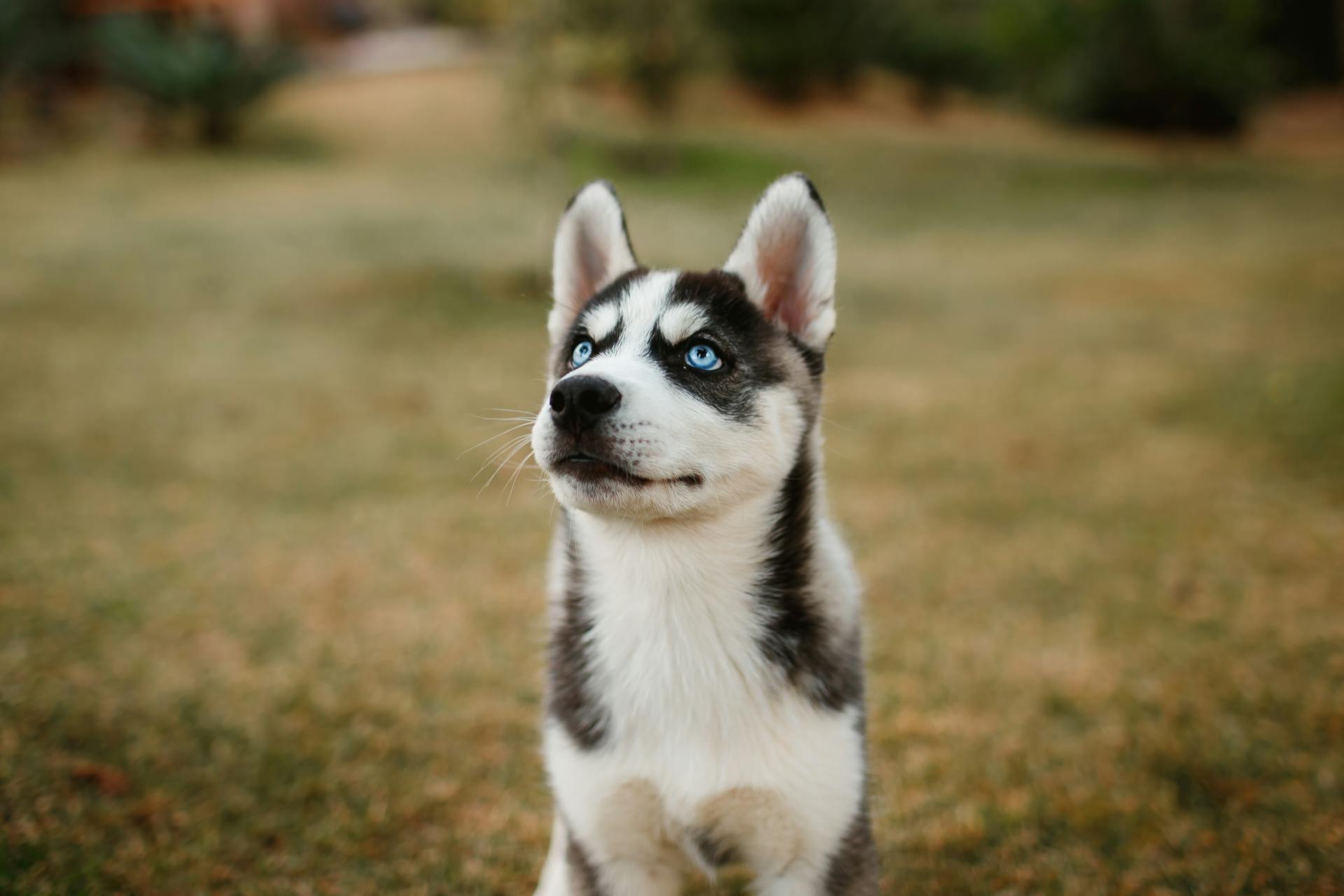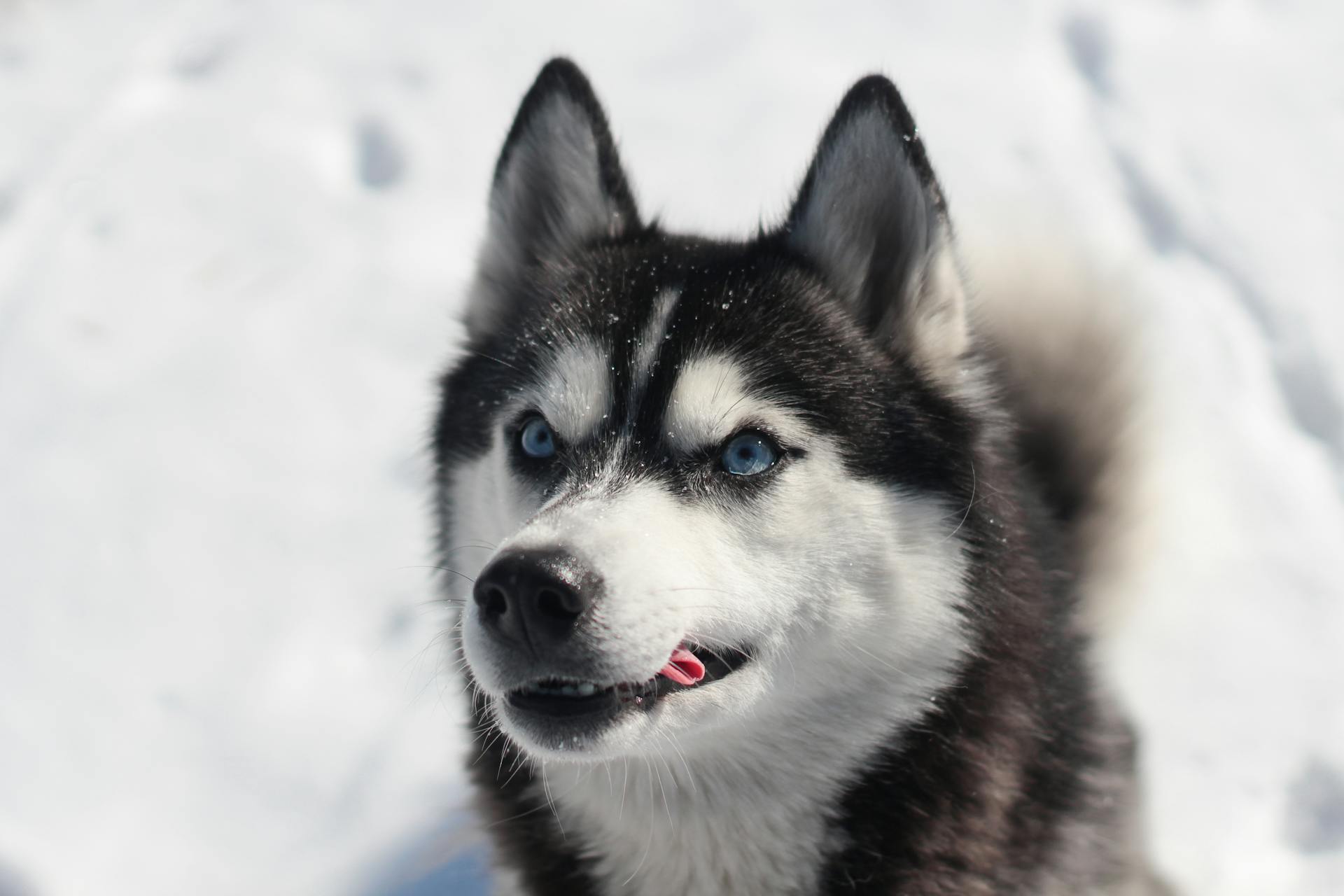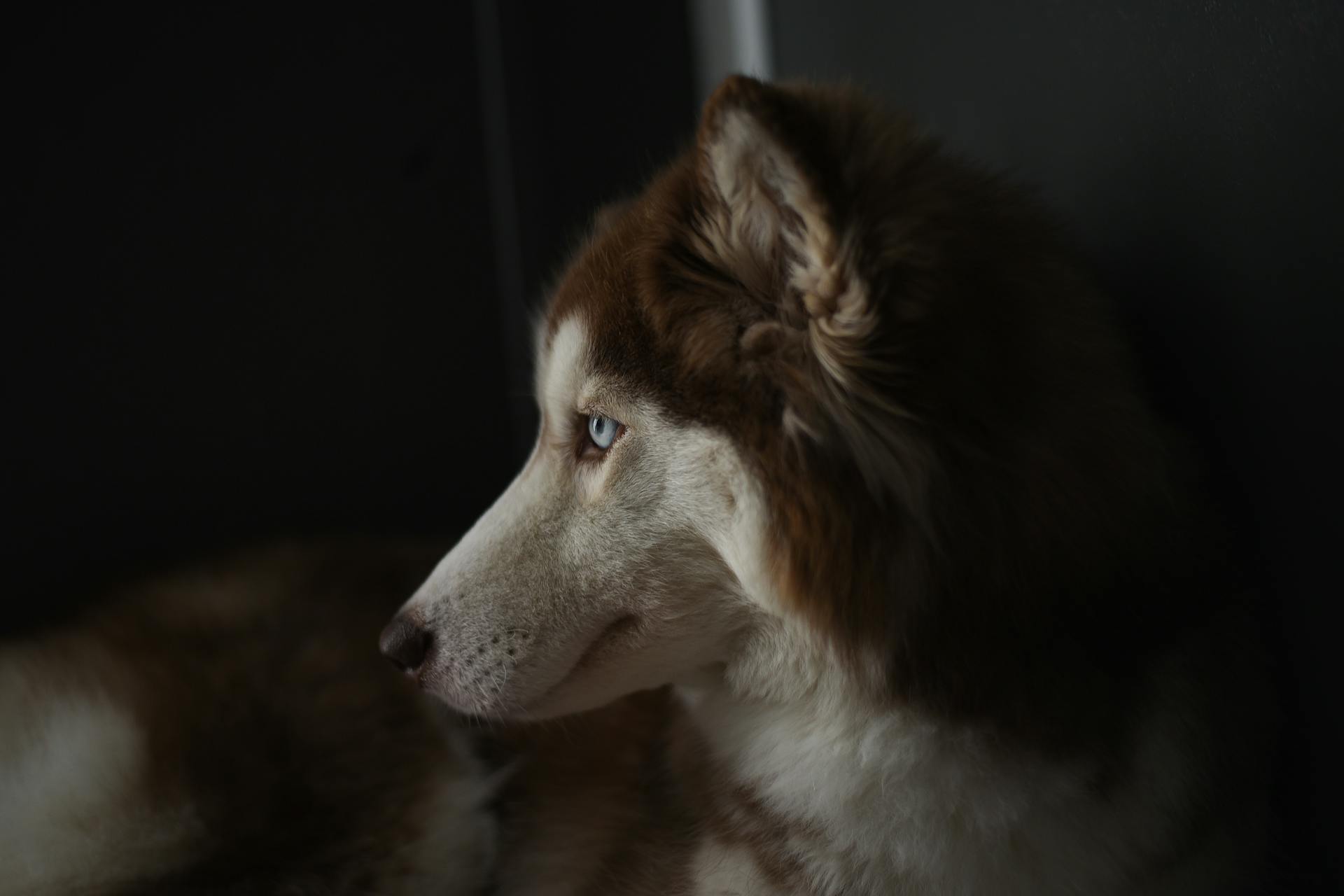
The Husky Malamute Mix is a unique and fascinating breed that combines the best qualities of both Siberian Huskies and Alaskan Malamutes.
They typically weigh between 60-85 pounds and stand between 23-26 inches tall at the shoulder.
Their thick coats require regular grooming to prevent matting and tangling, especially during shedding season.
These dogs are highly energetic and require regular exercise to stay happy and healthy, ideally at least 30 minutes of physical activity per day.
What is a Husky Malamute Mix?
The Husky Malamute Mix is a cross between a Siberian Husky and an Alaskan Malamute, two ancient dog breeds known for their strength, endurance, and friendly nature. They were originally bred to pull sleds and work in harsh Arctic conditions.
Their thick double coats are a hallmark of their heritage, with a thick undercoat and a coarser outer coat that sheds heavily, especially during shedding season. This means regular grooming is a must.
The Husky Malamute Mix is a medium to large-sized dog, weighing between 60-100 pounds and standing between 20-26 inches tall at the shoulder. They have a muscular build and a wedge-shaped head with a distinctive stop.
They are highly intelligent dogs that require regular exercise and mental stimulation to prevent boredom and destructive behavior. Daily walks and playtime are a must, as well as training and interactive toys.
Physical Characteristics
A husky malamute mix is a large-sized dog, typically weighing between 60 to 100 pounds and standing between 20 to 28 inches tall.
Their double coat is a key characteristic, with a dense undercoat and a coarse outer coat that sheds heavily, especially during seasonal changes. This coat type is water-resistant, making it perfect for cold climates.
Their coat colors can vary, but common combinations include silver, white, brown, gray, black, and cream. Some may also have facial masks and eye patches, adding to their unique appearance.
Here are some key physical characteristics of a husky malamute mix:
Overall, a husky malamute mix is a stunning dog with a unique appearance that's sure to turn heads.
Size Projections
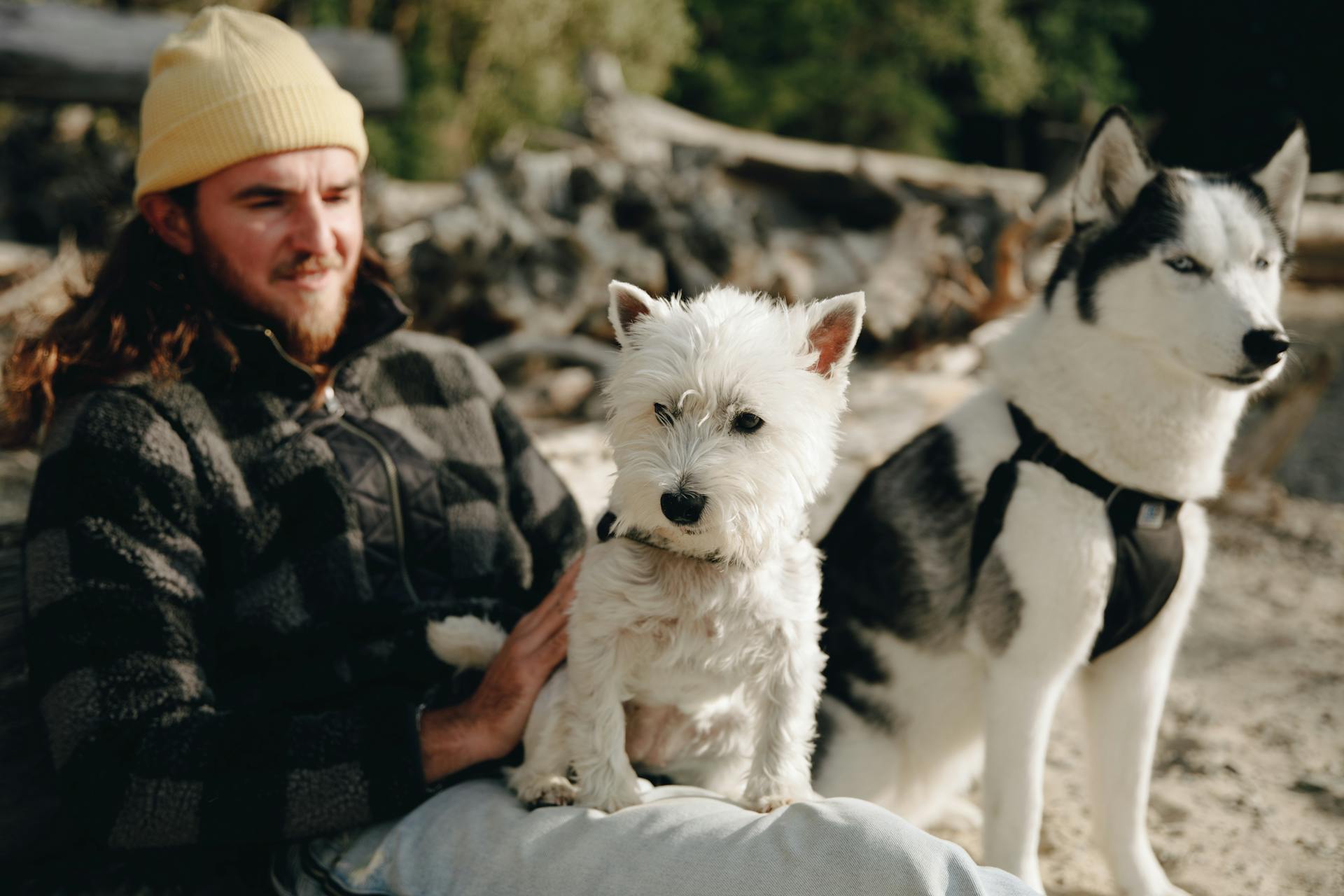
A full-grown Siberian Husky Alaskan Malamute mix can reach a height of 20 to 28 inches (51 to 71 cm) and a weight of 45 to 75 pounds (20 to 34 kg). Some can be as heavy as 100 pounds (45 kg).
These dogs are medium to large in size, with a muscular build. They have a thick double coat that's perfect for coping with harsh winter months.
Their height range gives you an idea of how much space they'll need in your home. If you're planning to bring one home, make sure you have enough room for them to stretch out.
Coat & Color: Fluffy Double-Coated Pooch
The Alusky's coat is a defining feature of this breed, and it's no surprise why - both parent breeds, the Alaskan Malamute and the Siberian Husky, are known for their thick, double coats.
Their coats are double-layered, with a soft undercoat and a coarser outer coat, making them water and ice-resistant. This is perfect for harsh winter conditions, but it also means they'll shed heavily, especially during spring and fall.
You can expect a wide range of coat colors, including white, silver, gray, brown, black, and cream, often with markings and facial masks. Some Aluskies may even have a little blue or red thrown into the mix.
Their coats can be quite thick, so regular grooming is a must to prevent matting and tangling. Brushing several times a week is a good rule of thumb, with daily brushing during shedding season.
Here's a breakdown of the Alusky's coat characteristics:
Overall, the Alusky's coat is a beautiful and functional feature that requires regular maintenance to keep it looking its best.
Care and Maintenance
The Alusky is a dog that thrives in cooler climates, but can adapt to hot temperatures.
To keep your Alusky's coat looking healthy, brush it several times a week, increasing to daily during shedding season.
You'll also need to dedicate time to grooming, which includes checking ears for signs of infection and clipping nails regularly.
A large yard for your Alusky to run around in is ideal, and a sandpit can be a great way to channel their digging instinct.
In addition to regular grooming, be sure to check your Alusky's ears weekly and clean them with a dog-specific ear solution and cotton balls.
You can also use Vaseline as a simple yet effective regimen for cracked paws if you live in a warm climate.
Regular oral hygiene is also important, so brush your Alusky's teeth at least once a week and trim their nails when you hear them clicking against the floor.
Breed Maintenance
The Alusky is a high-energy breed that requires regular exercise to keep them happy and healthy. This means you'll need to plan for at least an hour of physical activity, such as long walks or runs, every day.
Their thick coat requires regular brushing to prevent matting and tangling. Aim to brush your Alusky 2-3 times a week, or daily during shedding season. Use a slicker brush or undercoat rake to remove loose hair and prevent shedding.
The Alusky's large ears need regular cleaning to prevent bacteria buildup. Clean their ears weekly with a cotton ball and dog-specific ear solution. Never use a cotton swab, as this can cause damage.
Bathing your Alusky is not a daily task. In fact, it's recommended to bathe them only every 6-8 weeks to avoid damaging their natural coat oils. When you do bathe them, use an anti-shed shampoo and conditioner to keep their coat healthy and shiny.
Regular grooming is essential to prevent health issues and maintain your Alusky's appearance. Check their nails, eyes, nose, ears, and paws regularly for signs of irritation or infection. Use Vaseline to treat cracked paws, and schedule regular appointments with a groomer if you don't have time to do it yourself.
Here's a quick rundown of the Alusky's grooming needs:
By following these grooming guidelines, you'll be able to keep your Alusky happy, healthy, and looking their best.
Health Problems
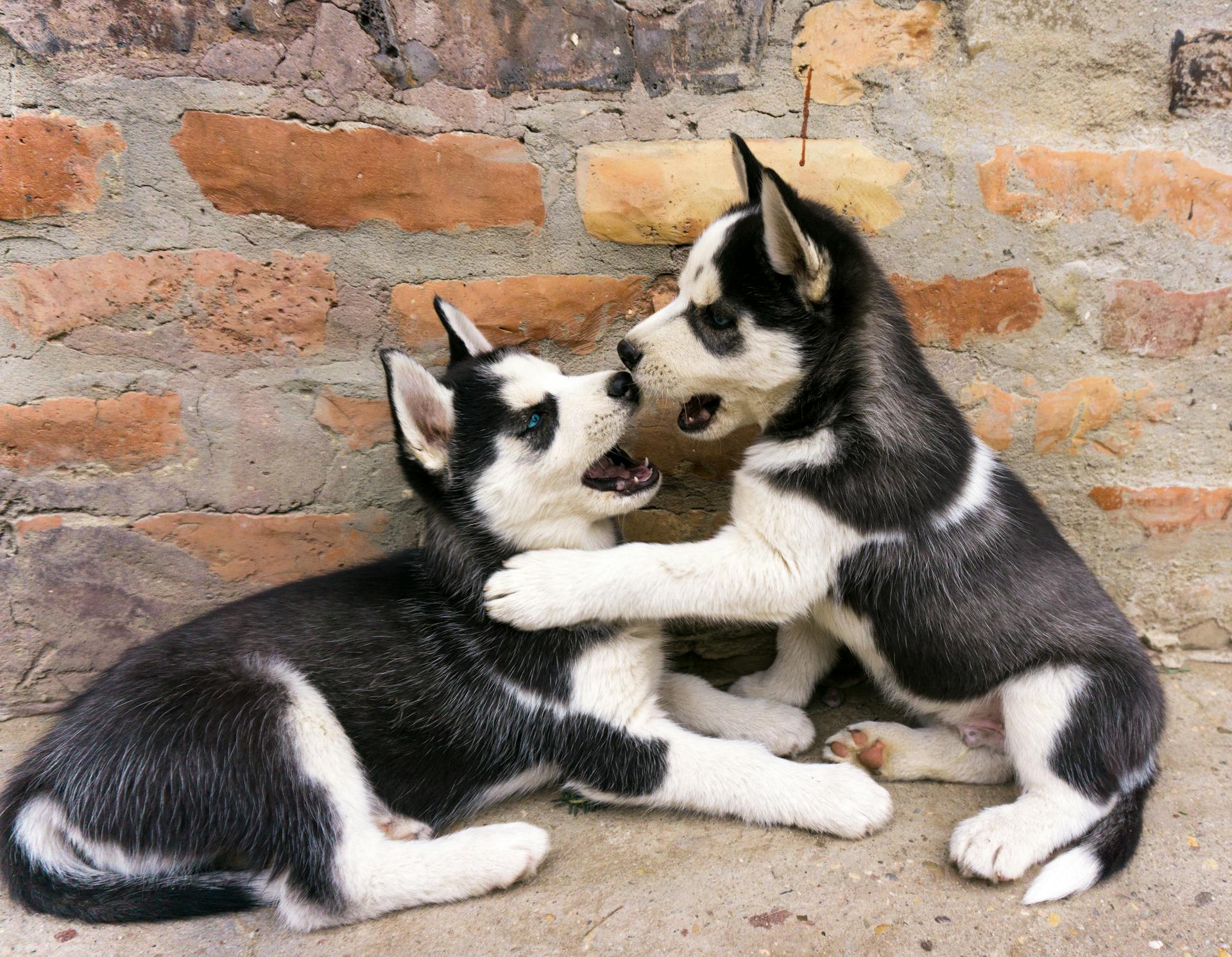
Your Alusky is a relatively healthy breed with a lifespan of 10 to 14 years, but like all breeds, they can suffer from different illnesses.
Hip dysplasia is a common condition that can lead to painful arthritis or joint inflammation, especially in their legs. It's essential to be aware of this condition and take preventive measures.
The Alusky can also inherit eye conditions from their parents, such as Cataracts, Corneal Dystrophy, and Progressive Retinal Atrophy, which can affect their vision.
Degenerative myelopathy is an incurable and devastating condition that can lead to paralysis of the hind legs, so it's crucial to be vigilant for any warning signs.
Von Willebrand disease is a bleeding problem that can manifest as excessive bleeding, causing owners extreme worry. Regular check-ups with a veterinarian can help identify any potential health issues.
Here are some common health concerns to watch out for in your Alusky:
Genetic testing and regular check-ups with a veterinarian can help you better understand your Alusky's health and catch any potential issues early on.
What to Feed an Animal
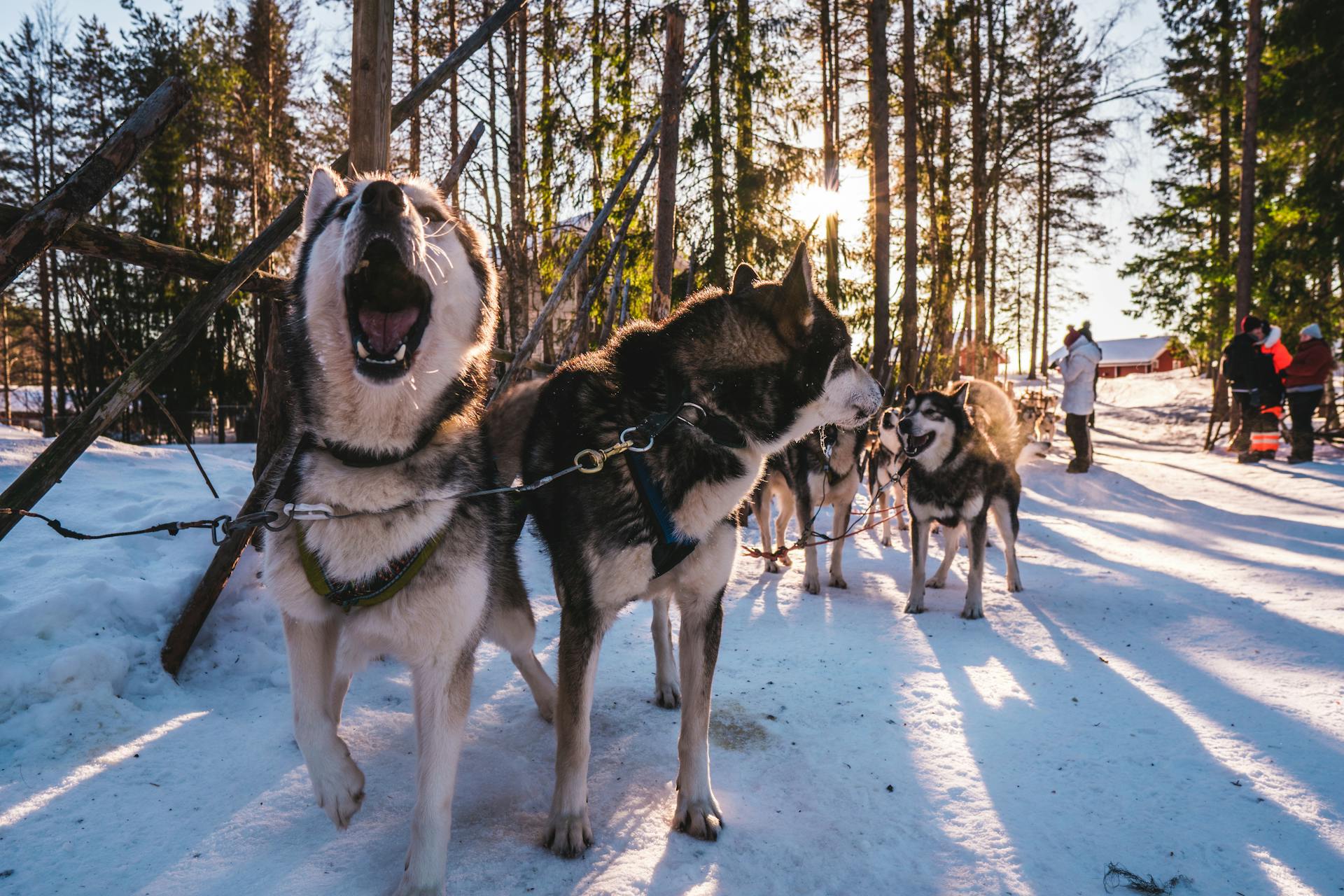
Feeding your husky malamute mix requires some careful consideration, but don't worry, I've got the lowdown.
A high-quality kibble with a high protein and calorie content is essential to keep your energetic dog sustained throughout the day. This means feeding around 3 to 3 ½ cups of food daily, depending on their energy levels.
Choose a kibble specifically designed for large dogs to help control rapid bone growth. This is especially important for husky malamute mixes, which have similar food needs to Siberian Huskies.
You'll want to divide the daily ration into two meals a day, with 3 to 5 cups of dry kibbles. This will help maintain a healthy weight and prevent obesity.
Opt for a premium large breed formula that features real meat as the primary ingredient, providing the protein necessary for muscle development and sustained energy. This is especially important for dogs with a thick double coat like the husky malamute mix.
Don't forget to add healthy dental treats to your dog's daily snack routine to maintain clean and strong teeth and gums.
As your dog ages, their nutritional needs will change, so be sure to adjust their diet accordingly. For example, senior dogs may need fewer calories but more protein than puppies.
For another approach, see: Purebred Malamute
Exercise and Training
The Husky Malamute mix needs a lot of exercise to stay happy and healthy. This means at least one hour of physical activity per day, with a combination of mental and physical stimulation. You can engage your dog in activities like learning tricks, running, hiking, and fetching.
To keep your dog's mind active, you can use toys like the Our Pets IQ Treat Ball Interactive Food Dispensing Dog Toy, which stimulates their mental health and improves digestion. It's also essential to provide a properly fenced backyard for physical activities, as these dogs have a knack for escaping and roaming around.
Here are some key exercise and training requirements for your Husky Malamute mix:
- Duration of physical activity: at least one hour per day
- Type of exercise: combination of mental and physical stimulation
- Recommended toys: Our Pets IQ Treat Ball Interactive Food Dispensing Dog Toy
- Backyard requirements: properly fenced with adequate space for physical activities
Training your Husky Malamute mix requires patience, consistency, and positive reinforcement. You can use techniques like crate training, positive rewards-based system, and basic commands like "come", "sit", and "stay". Remember to keep training sessions short and fun to prevent misbehaviors.
You might enjoy: Alaskan Malamute Training
Exercise Requirements
The Alusky needs around 90 minutes of exercise every day to keep his large body healthy and his intelligent mind stimulated. This is because he's one of the most energetic dogs around.
You'll need to mix up his exercise routine with activities like jogging, training sessions, swimming, and interactive games such as fetch and agility courses. This will help keep him engaged and prevent boredom.
A large, securely fenced backyard is a must for the Alusky, as he needs access to his own outdoor space where he can roam and play to his heart's content. Fences should be reinforced, as these dogs are known to dig their way out of enclosures and jump 6-foot fences.
The parent breeds of the Alusky are high energy dogs with sustained endurance, requiring at least one hour of physical activity per day. This can include activities like running, hiking, and fetching.
It's essential to provide mental stimulation for the Alusky, such as learning tricks and commands, to keep him engaged and prevent boredom. The Our Pets IQ Treat Ball Interactive Food Dispensing Dog Toy is a great way to do this.
Training
Training your Husky Malamute mix requires patience and consistency. These dogs are intelligent but can be stubborn at times, so it's essential to be supportive and firm.
Limiting the duration of training sessions can help prevent misbehaviors. Keeping sessions short will ensure your pup's undivided attention for a certain amount of time.
Crate training is a great way to help your dog become more relaxed when traveling. The duration of crate training ranges from 30 minutes for eight-week-old pups to eight hours for adult dogs.
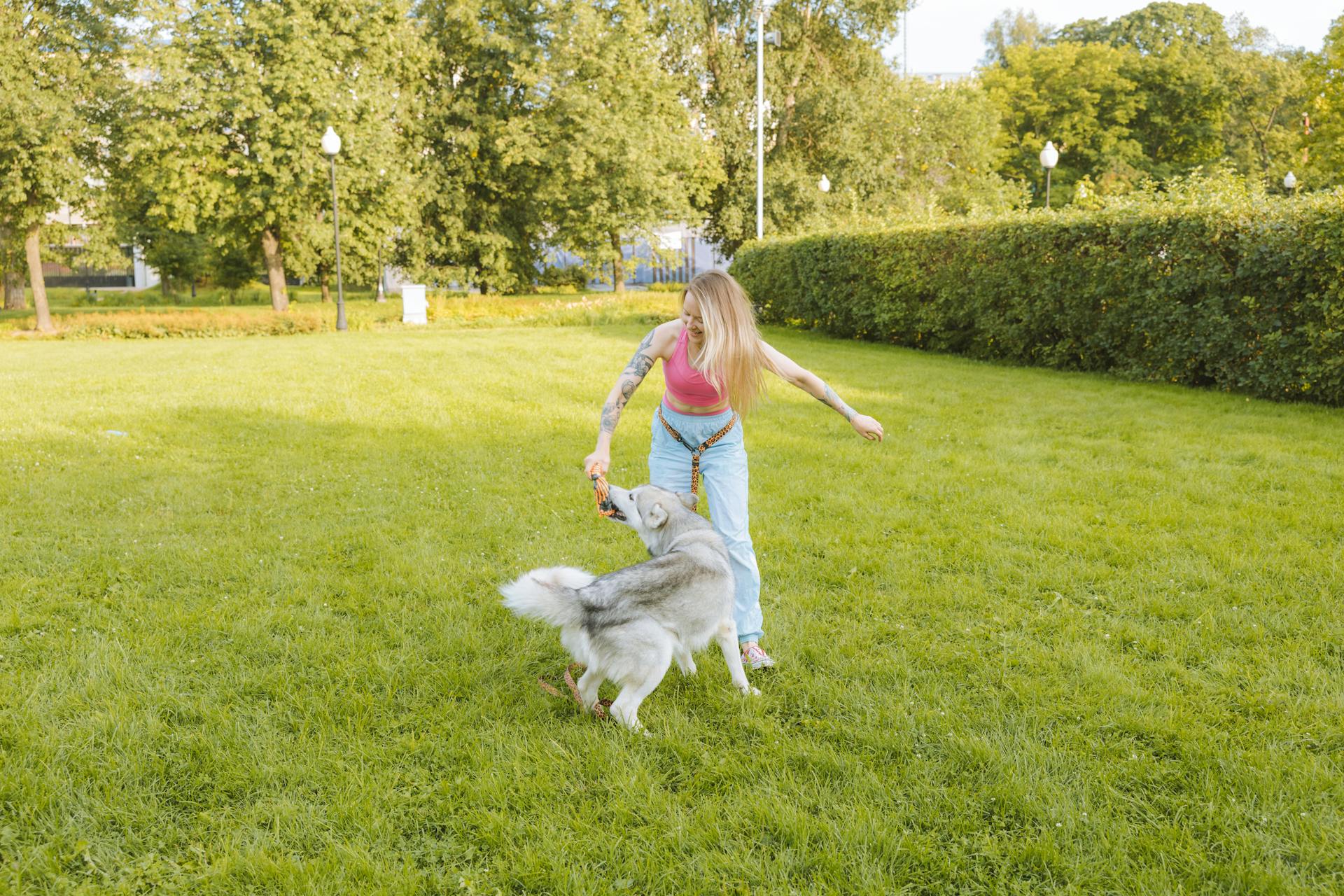
A positive rewards-based system is a great alternative to punishment. This technique involves giving treats and praise when your dog obeys, rather than scolding them when they don't.
Basic commands like "come", "sit", and "stay" are a great place to start. Giving an appropriate reward during the training process will help reinforce obedience skills.
Here are some tips to keep in mind:
- Limit training sessions to prevent misbehaviors.
- Use crate training to help your dog become more relaxed when traveling.
- Implement a positive rewards-based system to encourage good behavior.
- Start with basic commands like "come", "sit", and "stay".
Remember, consistency and persistence are key when training your Husky Malamute mix. With patience and the right techniques, you can help your dog become a well-behaved and loyal companion.
Family and Lifestyle
The husky malamute mix is a great family pet, but it's essential to consider their high energy levels. They need 60-90 minutes of daily exercise to stay happy and healthy.
If left bored or unexercised, they can become destructive, so make sure to provide plenty of physical and mental stimulation. A yard with space to roam is ideal, but even a short walk or playtime in a park can help.
Socialization is crucial for this breed, especially during the first six months of their life. Early socialization will help them grow into a fearless and confident adult, and it's best to start as early as 2 1/2 weeks old.
Here are some key things to keep in mind when considering a husky malamute mix as a family pet:
- They are generally good with children, but it's essential to teach them how to respect and play with the dog within respectable bounds.
- They can be protective, but they are also social and can get along well with visitors.
- They are highly intelligent and demand constant attention and play.
- They require an owner who can spend a lot of time with them and provide early socialization and training.
Families
The Alusky is an excellent family pet, known for its goofy and loyal personality. They're well-balanced, affectionate, and polite dogs, making them great with children and other pets.
Just supervise play to avoid accidents when everyone's having too much fun. They're naturally suspicious, which is an excellent quality for any breed.
The Alusky is highly intelligent and demands constant attention and play. They require an owner who can spend a lot of time with them and provide early socialization and training.
Here are some key things to keep in mind when considering an Alusky as a family pet:
They're great with children, but it's essential to teach your kids how to respect and play with the dog within respectable bounds. Positive affirmations are necessary to help the dog settle with their new home.
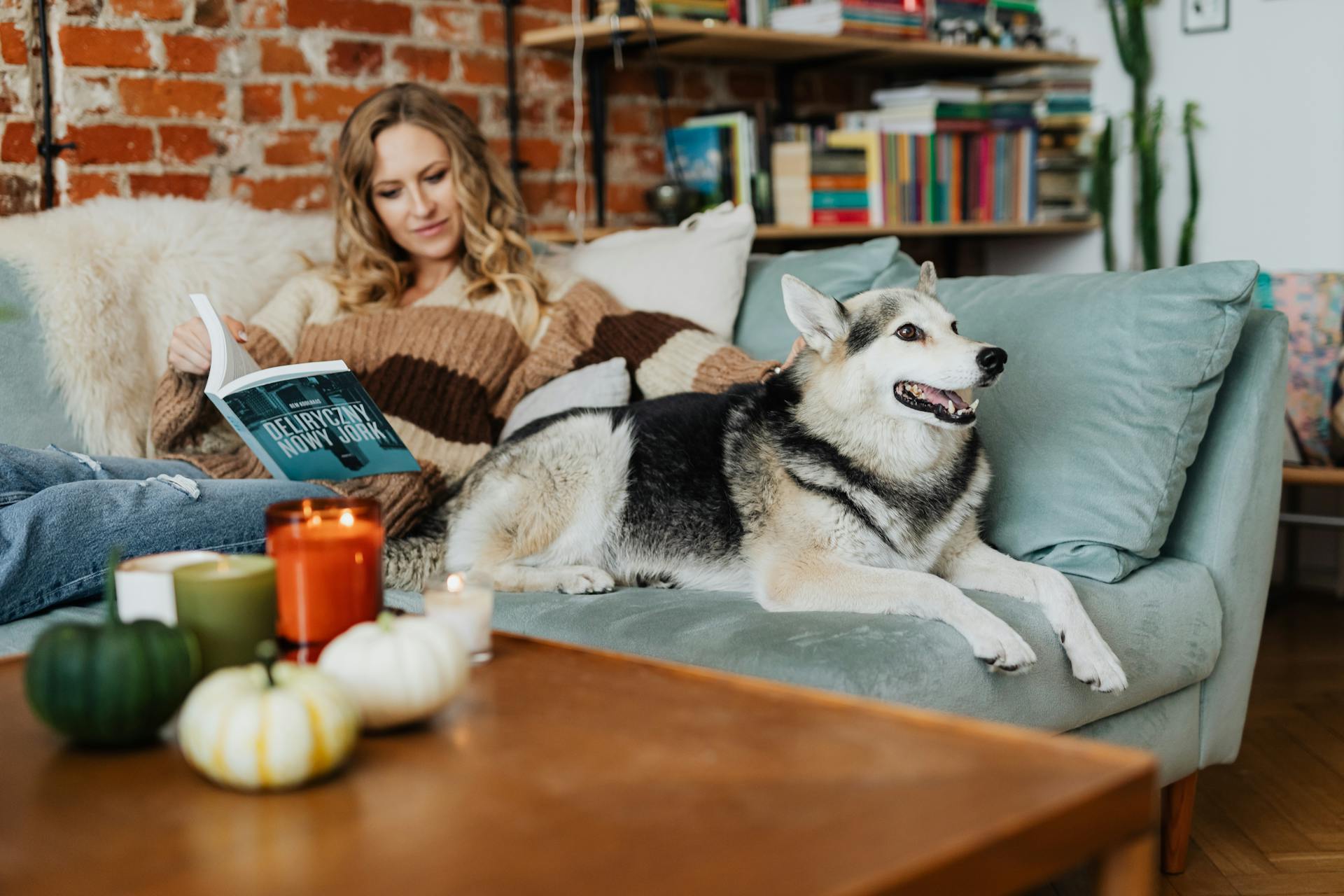
The Alusky will thrive in a yard with space to roam, and they need 60-90 minutes of daily exercise to stay happy and healthy. If left bored or unexercised, they can become destructive.
Despite their size, the Alusky is a good pick for young families, as they love to spend time with the younger family members. However, they can be extremely stubborn, so owners need to be firm yet consistent with training.
3 Reasons Not to Get a Dog
If you're thinking of getting a dog, there are some things to consider. Some breeds can be quite high-maintenance, and it's essential to think about whether you're ready for the responsibility.
Firstly, some dogs can be quite loud and may disturb your neighbors. This is particularly true for breeds that tend to howl, like the Husky Malamute mix, which can be a real issue if you live in an apartment or have close neighbors.
You might enjoy: Husky Hybrid Dogs
Dogs also have specific needs when it comes to their environment. For example, some breeds prefer colder climates due to their thick coats, which can make them unhappy in warmer temperatures.
If you're new to dog ownership, you may find that some breeds can be quite stubborn. This is especially true for the Husky Malamute mix, which can become headstrong and independent if not trained properly from an early age.
Here are some factors to consider before getting a dog:
- Loudness: Some breeds howl, which can disturb neighbors.
- Environmental needs: Some breeds prefer colder climates.
- Trainability: Some breeds can be stubborn and require early training.
Remember, getting a dog is a big decision, and it's essential to think carefully about whether you're ready for the responsibility.
Finding and Cost
Finding a Husky Malamute mix puppy can be a challenge due to their rarity. The price of an Alusky puppy can range from $1,000, depending on factors like the breeder's location and the pup's availability.
Additional annual expenses include medical care, which can cost between $400 to $500, as well as non-medical costs such as food, crates, leashes, and toys, which can range from $300 to $500.
To find a reputable breeder, it's essential to do thorough research and look for breeders who care about the dogs' well-being and health. Some warning signs of unreliable breeders include a lack of knowledge about the breed, incomplete medical history and health tests, and pedigree documentation.
You can also get a glimpse of the puppy's upbringing by visiting the breeder's quarters personally. The American Society for the Prevention of Cruelty to Animals (ASPCA) strongly discourages buying puppies online.
Readers also liked: Alaskan Malamute Breeders in Alaska
Puppy Cost
The cost of an Alusky puppy can be a significant investment, but it's essential to consider the overall expenses involved in caring for a dog. An Alusky puppy can cost around $1,000.
Annual expenses for an Alusky include medical costs, which can range from $400 to $500, and non-medical expenses, such as food, crates, leashes, and toys, which can add up to $300 to $500.
It's also crucial to research the breeder's reputation and ensure they provide high-quality care and maintenance for the dogs. Reputable breeders may charge a higher price, starting from $1,000, to compensate for the care and attention given to the puppies.
Here's a breakdown of estimated annual expenses for an Alusky:
Remember, buying from a reputable breeder may cost more upfront, but it's a worthwhile investment in the long run for the health and well-being of your Alusky puppy.
Finding for Adoption
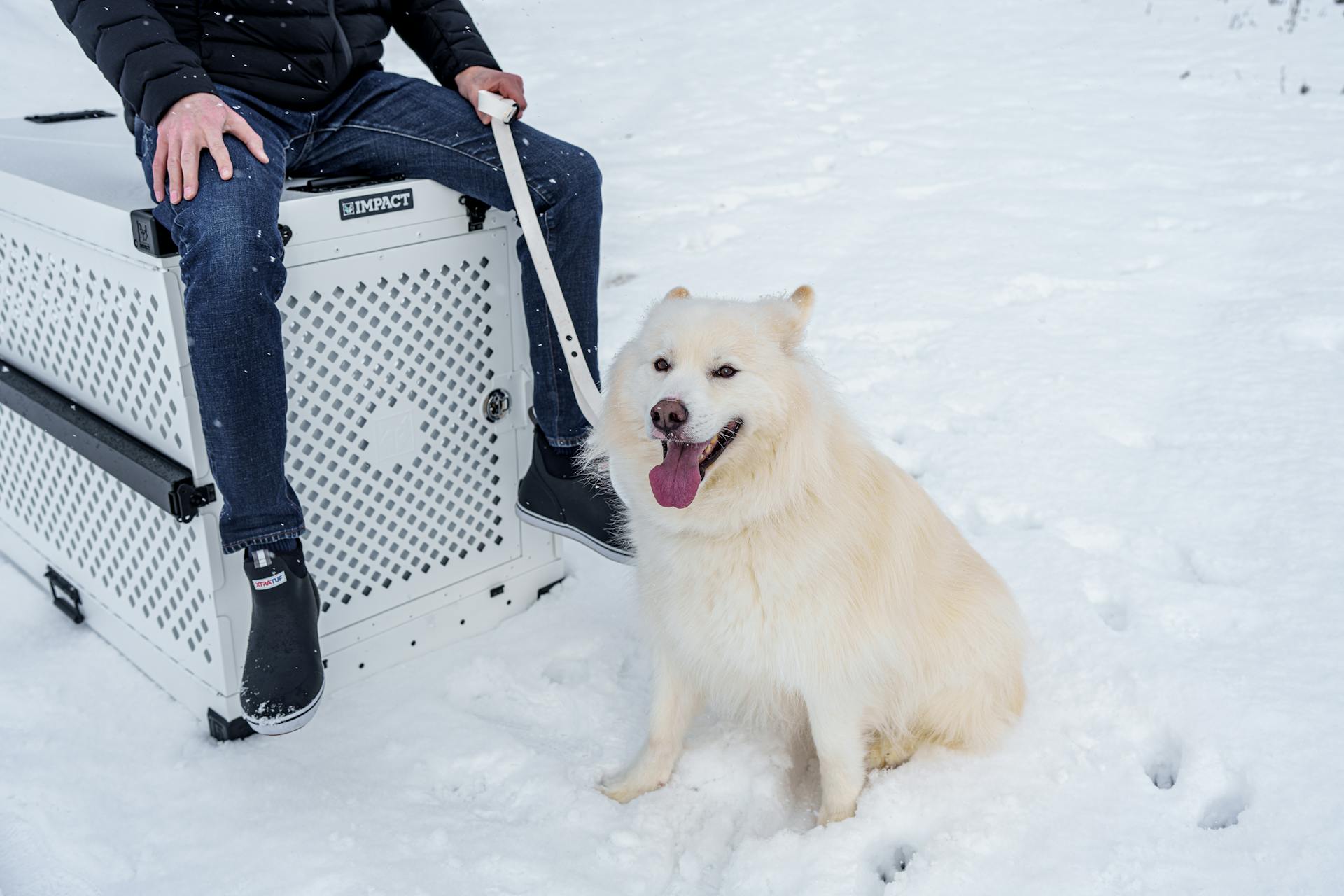
If you're looking to bring an Alusky into your life, adopting from a rescue organization can be a wonderful option. You can start by checking with local shelters near you, but you may also want to reach out to specific rescue organizations for Siberian Huskies and Alaskan Malamutes.
These organizations often cater to their mixes, including Aluskies, so you may be able to find your new furry friend there. Some great places to check out include Howling Woods Farm in Jackson, NJ, WAMAL in Spokane, WA, and Free Spirit Siberian Rescue in Harvard, IL.
If you're lucky, you might find an Alusky waiting for you at one of these organizations.
If this caught your attention, see: Malamute Dog Rescue
Breed Information
The Alusky breed is a medium to large size dog with a muscular build, covered in a thick double coat that's perfect for withstanding harsh winter conditions.
Their appearance can vary depending on which parent breed they take after, with some looking more like a Malamute and others taking after their Husky relations.
Alusky puppies come in a wide range of colors, including red, brown, cream, white, silver, light brown, gray, golden, salt and pepper, or any combination of these.
Their facial features are wolf-like, with large erect ears and a long, narrow muzzle.
For another approach, see: Brown Husky Mix
Alaskan Breed Basics
The Alaskan Malamute breed has a long history in the Arctic region, with a strong and impressive presence that dates back to an Inuit tribe based in northwestern Alaska.
They're large in frame and incredibly strong, capable of pulling heavy loads and hunting animals the size of polar bears and seals.
A good example of their strength is Admiral Richard Byrd's second Antarctic expedition in 1933, where he took a number of Alaskan Malamutes along.
These dogs are a lot more protective than the Siberian Husky, taking the role of family guardian seriously and adoring their human family very much.
Alaskan Malamutes stand 23 to 25 inches tall, from paw to shoulder, and weigh between 75 and 85 pounds, making them a medium- to giant-sized dog.
They're not suited for crowded places like apartments, so make sure you have enough space for them to move around.
In terms of temperament, Alaskan Malamutes have a perfectly mixed personality, being very protective of their families while also being gentle and friendly.
They're known to be super playful despite their stern exterior look, which makes them a great companion for active families.
As a breed, Alaskan Malamutes rank 58th in American Kennel Club's (AKC) breed popularity and are part of the Working Group.
Related reading: Are Alaskan Malamute Good Family Dogs
Health Risks
The Alusky is generally a healthy breed, but like all breeds, it can be prone to certain health issues. A lifespan of 10 to 14 years is expected, although some may live up to 15 years with proper care.
Hip dysplasia is a common condition that can cause painful arthritis and joint inflammation. It's often inherited from the parents and can be triggered by rapid bone growth as a puppy.
Eye conditions are also a concern, with both parents being susceptible to cataracts, corneal dystrophy, and progressive retinal atrophy. These conditions can affect vision and may lead to blindness.
Degenerative myelopathy is an incurable condition that can cause paralysis of the hind legs. It's essential to be aware of the warning signs and have regular check-ups with a veterinarian.
Von Willebrand disease is a bleeding disorder that can cause excessive bleeding. It's crucial to monitor your Alusky for any signs of this condition.
Here are some specific health risks to watch out for:
Regular check-ups with a veterinarian and genetic testing can help identify potential health issues early on. By being proactive and aware of these health risks, you can help ensure your Alusky lives a long and healthy life.
For your interest: Alaskan Malamute Health Problems
Frequently Asked Questions
What is the temperament of an Alusky?
The Alusky temperament is intelligent and independent, but can be stubborn at times. Consistent and firm training is key to establishing leadership and a well-behaved companion.
How much does an alusky cost?
Aluskies typically cost around $1,000 due to their high demand and popularity as a hybrid breed.
What is a Siberian Husky Malamute mix called?
The Siberian Husky Malamute mix is commonly known as an Alusky. This energetic hybrid breed makes a great pet for active families or couples.
Featured Images: pexels.com
